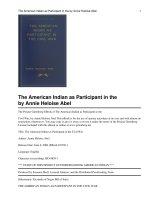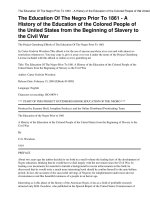-This is in Brief My Remenence of My Army Life- The Civil War Mem
Bạn đang xem bản rút gọn của tài liệu. Xem và tải ngay bản đầy đủ của tài liệu tại đây (1.27 MB, 7 trang )
Kennesaw State University
DigitalCommons@Kennesaw State University
Faculty Publications
3-2005
“This is in Brief My Remenence of My Army Life”
The Civil War Memoir of Louis Bir
J. D. Fowler
Kennesaw State University,
Follow this and additional works at: />Part of the Military History Commons, and the United States History Commons
Recommended Citation
Fowler, J. D. ""This is in Brief My Remenence of My Army Life"." Indiana Magazine of History 101.1 (2005): 3-8. Print.
This Article is brought to you for free and open access by DigitalCommons@Kennesaw State University. It has been accepted for inclusion in Faculty
Publications by an authorized administrator of DigitalCommons@Kennesaw State University. For more information, please contact
“This is in Brief My
Rernenence of My army Life”
The Civil War Memoir of Louis Bir
J. D. FOWLER
L
ouis Bir was a typical Civil War soldier in most respects. He was
young, only nineteen years old at the time of his enlistment in the
Ninety-Third Indiana Volunteer Infantry Regiment in 1862, and he was
anxious for a grand adventure. For the remainder of the war, Bir traveled
across the Western Theater, experiencing the horrors of combat, the
agony of wounds, and the monotony of camp life. Fortunately for future
generations of historians, Bir was atypical of most Civil War soldiers in
that he left a record of his experiences. This record offers a fascinating
glimpse into the life of one “Billy Yank.”’
J. D. Fowler is assistant professor of history, Kennesaw State University, Kennesaw, Georgia. He
is the author of Mountaineers in Gray: The Story of the Nineteenth Tennessee Volunteer Infantry
Regiment, C.S.A. (2004) and Awash in the Storm: Tennessee During the Civil War Era (forthcoming)
‘The best general studies of the experiences of Civil War soldiers are Bell Wiley, The Life of
Johnny Reb: The Common Soldier of the Confederacy (1943; reprint, Baton Rouge, La., 1996);
Wiley, The Life ofBilly Yank: The Common Soldier ofthe Union (1952; reprint, Baton Rouge, La.,
1995);James Robertson,Jr., Soldiers Blue and Gray (Columbia, S.C., 1988); Reid Mitchell, Civil
War Soldiers: Their Expectations and Their Experiences (New York, 1988); Gerald E Linderman,
Embattled Courage: The Experience of Combat in the American Civil War (New York, 1987);
James M. McPherson, What They Fought Fol; 1861.1865 (New York, 1994); McPherson, For
Cause and Comrades: Why Men Fought in the Civil War (New York, 1997).
INDIANA MAGAZINE OF HISTORY, 101 (March 2005) 0 2005, Trustees of Indiana University
4
I N D I A N A MAGAZINE OF HISTORY
Louis Bir in his Civil War uniform
Courtesy Vicki Blemker
Bir’s reminiscences, like other recollections of the war, paint a
poignant picture of the hardships of army life. He vividly describes his
hunger, the poor quality of food, and his many marches across the
southern countryside. Because it was produced by, about, and for members of a unit or fellow veterans, Bir’s account is categorized as a firstgeneration narrative. Often these records have serious limitations for
students of the war. Many of the authors penned their histories decades
after the events described, allowing time and distance to cloud memo-
C I V I L WAR M E M O I R S
ries and distort recollections. In addition, first-generation histories
almost always portray the author and his unit favorably. Incidents of
cowardice, desertion, or ineptitude often are not mentioned or are presented as aberrations. Also, these narratives, while usually paying hagiographical tributes to brigade and regimental officers, tend to omit
important details about the heart of all Civil War regiments-the fighting men.z
Sergeant Bir’s account, however, is different from unit histories in
two important ways. First, it is not actually a unit history but rather a
personal memoir. Apparently, Bir intended his recollections to be delivered as an oral presentation, perhaps to his fellow veterans in the Grand
Army of the Republic. Also, his recollections offer us an unsanitized
view of the war. Indeed, the most striking aspect of Bir’s memoir, and
what truly makes it unique, is the author’s honesty. Bir’s willingness to
admit to being a thief, an immature boy who cried over practical jokes,
and a racist gives much credibility to his entire story.
Several key points emerge that highlight the importance of this
work. For example, it is odd that Bir does not give a reason for his enlistment. He does not express any patriotic sentiment, nor does he mention
any community or kinship pressure he may have experienced. Either Bir
expected his audience to understand his motivations for fighting for the
Union, or he did not consider them worth mentioning. Perhaps if he
intended his audience to be other veterans, he felt comfortable enough
to let his guard down and speak openly about issues and events that
other veterans would understand. For example, Bir talks candidly about
pillaging with his comrades. Their bounty included pies, a turkey, chickens, honey, and a calf. He recalls a southern woman pleading with him
’A handful of historians have attempted to generate modern scholarly regimental studies using
a variety of primary sources, including individual military records, census records, pension
records, medical records, newspapers, diaries, and personal papers in order to create a composite picture of the men of a regiment-the basic unit of the Civil War armies. Leslie Anders’s two
hooks, The Eighteenth Missouri (Indianapolis, 1968) and The Twenty-first Missouri: From Home
Guard to Union Regiment (Westport, Conn., 1975), are both first rate in their use of sources and
their emphasis on the experiences of the common soldier. Likewise, Edward J. Hagerty’s Collis’
Zouaves: The 114th Pennsylvania Volunteers in the Civil War (Baton Rouge, La., 19961, Douglas
Hale’s The Third Texas Cavalry in the Civil War (Norman, Ok., 1993), Ben Wynne’s A Hard Trip:
A History of the 15th Mississippi Infantry, CSA (Macon, Ga., 2003), and John D. Fowler’s
Mountaineers in Gray: The Nineteenth Tennessee Volunteer Infantry Regiment, C.S.A. (Knoxville,
Tenn., 2004) are studies that go beyond the “bugles and bullets” to discuss motivation, socioeconomic status, war weariness, and the daily routine and struggles of ordinary combat soldiers.
5
6
I N D I A N A M A G A Z I N E OF HISTORY
and his fellow soldiers not to take her calf because it was all she had.
However, he confesses that the Union troops ignored the old woman’s
pleas, killed the animal, and carried it away while being pursued by
Rebel troops. Obviously, Bir felt no guilt for his actions, nor, apparently,
did he care if his audience viewed him negatively.
Bir’s memoir contains several graphic passages related to combat.
He remembers killing his first man as his regiment retreated following
Nathan Bedford Forrest’s rout of Union forces at Brice’s Crossroads.
Even though Bir had undoubtedly fired into Rebel ranks before, perhaps
wounding and killing any number of soldiers, this was the first time he
had watched a man die in front of him and realized that he had taken a
life. The memoir also contains gruesome reminders of the horrors of
war. At the battle of Nashville he writes of seeing the man next to him
cut in half by a shell and watching as his internal organs emerged from
the shattered body. Later, as night brought an end to the fighting, he
could not sleep because a Rebel soldier lying nearby had suffered a
ghastly head wound. Bir watched and listened in horror as the soldier’s
brains oozed out with each of his final breaths. Such graphic portrayal is
real and brings the brutality of war home to the reader.
Bir’s account is also interesting because he neglects to discuss the
Confederate soldiers in detail. In fact, he rarely refers to the Rebels as
individuals. One gets the sense that they are simply the enemy.
However, while Bir may have dehumanized his opponents, he does not
apparently hate them. In fact, he makes no derogatory comments about
the Rebels other than the mention that he and his comrades contracted
lice by sleeping in an abandoned Confederate camp. He does remember
Confederates shooting prisoners, but he also describes his anger over
Union troops executing Rebel captives. He tells about the time a Rebel
allowed him to ride a horse during an exhausting march toward
Andersonville, and he recalls how he enjoyed listening to the
Confederate bands sent to entertain the Federal troops at night. Even the
death of his childhood friend does not appear to evoke rage or hatred.
Indeed, Bir does not seem to have harbored any overt hatred for the men
who tried to kill him for three years. In a sense, the Confederate forces
appear to be just another obstacle, like the weather or lack of food, that
must be overcome.
While Bir seems indifferent to southern soldiers, he apparently
liked southern civilians. He became infatuated with a girl in Memphis,
visiting her after the war to see if the spark could be reignited. Also,
during a stint at occupation duty near Meridian, he helped local planters
C I V I L WAR M E M O I R S
convince the newly freed slaves to remain on the plantations as free
laborers. Bir was forced to kill a freedman while performing his policing
duties. His only regret was having to ride sixty miles round trip to report
the killing to the nearest Provost Marshal. Bir’s callousness here reveals
one of the least likeable facets of his personality, but it is one of the most
important dimensions of his memoir-racism. While Civil War scholars
have documented that the overwhelming majority of white Union
troops were as racist as their southern counterparts, this fact is often lost
on the general public. Less than ten percent of the white northern public harbored abolitionist sentiment by 1860, and many of those individuals would be considered racist by modern standards. Many white
Union troops, especially those from the Midwest, did not like African
Americans and resisted the idea that they were fighting for emancipation. While it cannot be denied that southern slave holders were fighting
to perpetuate the institution, it is equally true that the majority of white
Union troops could have cared less about the fate of the slaves. For
them, the Union remained their cause. Indeed, as historians of the war
have noted, virtually all white Union troops supported the war to save
the Union, and if they supported emancipation, it was only as a war aim
designed to weaken the South.3
Bir’s work shows clearly that he and his comrades were products of
their society’s racial and ethnic biases. In addition to the racism portrayed, Bir mentions the looting by Union forces of Jewish-owned businesses in Cairo, Illinois, and the unwillingness of Union commanders to
stop it. Bir himself stole a barrel of eggs while others tossed a hog
through the window of a Jewish merchant’s shop. Bir even recalled seeing one of his comrades “shoot down” a Jew who would not grant him
credit .
Bir’s honesty is disturbing yet refreshing. Many post-war accounts
were carefully sanitized and self-serving. Since Bir intended for his reminiscences to be read to fellow veterans at reunions, he apparently
believed that his audience would be receptive to his positions and experiences. We, of course, do not know how his stories were received or if
those present shared similar attitudes. However, Bir’s account should
’For a good analysis of the attitude of Northern white troops toward African Americans, slavery,
and emancipation, see the following: McPherson, What They Fought For, 56-69; McPherson,
For Cause and Comrades, 117-30; Wiley, The Lqe of Billy Yank, 109-23; Mitchell, Civil War
Soldiers, 14-15, 41-42,91, 104, 119, 121-23, 126-31, 197-98.
7
8
I N D I A N A MAGAZINE OF HISTORY
find a responsive audience among modern students of the war. The
memoir offers social, regional, and Civil War historians a valuable primary source and takes the general public on a fascinating journey into
the past as seen through the eyes of someone who was there. The
author's candid portrayal of his experiences from diarrhea to watching
men die offers us a chance to see what Walt Whitman lamented would
never get into the books-the real war?
'Gay Wilson Allen and Sculley Bradley, eds., The Collected Writings of Walt Whitman, 2 vols.,
Prose Works 1892: Specimen Days (New York, 1963), 115-18.









